Comprehensive Utilization of Seawater in China: A Description of the Present Situation, Restrictive Factors and Potential Countermeasures
Abstract
1. Introduction
2. Seawater Desalination in China
2.1. The Course of Desalination Development
2.2. The Status Quo of Desalination Development
3. Direct Utilization of Seawater in China
3.1. The Development Status Quo of Once-Through Seawater Cooling
3.2. Direct Utilization of Seawater in Other Ways
4. Utilization of Seawater as a Chemical Resource and Structural Optimization in China
4.1. Utilization of Seawater as a Chemical Resource
4.2. The Optimization of the Recycling Industry Chain
- Taking seawater as a raw material, obtain Freshwater and retentate brine through the desalination process.
- Produce bromine by applying the air blow-out method to retentate brine and obtain debrominated brine.
- Add NaOH and Na2CO3 to the debrominated brine to produce magnesium hydroxide and calcium carbonate and refine the brine.
- Produce sodium sulfate decahydrate by applying the freezing method to the refined brine and obtaining desulfurized mother liquor.
- Produce sodium chloride by applying high-temperature evaporation to the desulfurized mother liquor and obtaining the mother liquor of salt.
- Produce potassium chloride and potassium mother liquor by low-temperature evaporation. The mother liquor is then circulated into the extraction process of sodium sulfate by the freezing method.
5. Restrictive Factors and Potential Countermeasures for the Comprehensive Utilization of Desalinated Seawater in China
5.1. Low Localization Rate of Key Technologies and Equipment
- The “Special Plan for Seawater Utilization” introduced in 2005 proposed that the localization rate of desalination equipment should be 90% or more by 2020. Considering the current development situation, we should carry out independent innovation in terms of process optimization, cost reduction and research into the key equipment and technologies. The leading domestic manufacturers are Hangzhou Big Dipper Membrane Products Co., Ltd., Beijing Shidai Walton Technology Co., Ltd., Bluestar Co., Ltd., Tianjin Motiammo Co., Ltd., and Hainan Lisheng Water Purification Technology Co., Ltd. The domestic market share of desalination membranes is approximately 10% [82]. The Vontron reverse osmosis membrane produced by Beijing Shidai Walton Technology Co., Ltd. has passed the NSF certification in the United States and has distributors, agents and fixed customers around the world [83,84]. Construction of the largest domestic reverse osmosis membrane project began in Beijing in August 2009, and this project is jointly built and financed by Bluestar Co., Ltd. and the Toray Company in Japan [85].
- At the same time, seawater desalination demonstration projects should be constructed. By encouraging enterprise and scientific research institutes to incorporate the latest research achievements (especially innovations in key pieces of equipment, such as reverse osmosis membranes, energy recovery devices, high-pressure pumps, and evaporators) into demonstration projects to be tested and improved, we could gradually realize the localization of desalination equipment manufacturing. The Southern Pump Industry Company undertook the “Research, Development, Application and Demonstration of Energy Recovery Devices for Desalination” project of the “Key Equipment for Reverse Osmosis Desalination Development” national science and technology support plan during the “12th Five-Year Period”, which has resulted in the local production of energy recovery devices. The research work of this company is progressing, and preparations are being made for third-party testing. In addition, the biggest single-plant high-pressure pump in China, the pump used in the Zhoushan Liuheng desalination project, which was developed by the Southern Pump Industry Company and has a daily capacity of 12,500 m3 and was put into operation during the second phase of the project in 2014. Its acceptance indicates that the localization rate of the key technology of desalination membranes is further improving.
5.2. High Economic Costs
- To reduce the cost of energy consumption and pretreatment, the combination of nuclear power and desalination has become an important development trend. The combination of these systems meets the need for cooling water in nuclear electricity generation. On the other hand, it provides cheap energy for desalination, creating the necessary conditions for the large-scale utilization of seawater. At present, the first combined nuclear power plant and seawater desalination system built in China, the Liaoning Hongyanhe nuclear power plant, is working well. The first nuclear power project approved during the “11th Five-Year Period”, the Hongyanhe nuclear power plant, has four machine sets and a scale of a million kilowatt-hours. It greatly alleviates water shortage conditions and breaks new ground to effectively solve the problem of freshwater supply to nuclear power plants.
- As the first city to introduce the use of desalinated seawater, Qingdao has leading significance for the nationwide implementation of this practice in terms of demonstrating the feasibility, method of operation, and the means of subsidizing and financing the project. In another case, the Caofeidian desalination project was adopted by the Hebei Development and Reform Commission in 2014. It is expected to produce water for Beijing beginning in 2019. This large-scale project, which has a daily capacity of 1,000,000 m3, will meet one-third of the water demand of Beijing. The cost of the desalinated seawater will be 7–8 RMB/m3, however, the cost of domestic water in Beijing is 4 RMB/m3. Clearly, there is a certain gap between these water prices, which is supposed to be adjusted gradually in the future.
5.3. Insufficient Water Production Rate of Desalination Plants
- Given the current desalination cost level, direct subsidies from the government are indispensable in solving the problems related to the large-scale idling of capacity. The attitude of the government largely determines whether seawater desalination can be carried out on large scales in urban water supply systems. As a city manager would do, the government should not just regard the water supply as a financial and technical problem. It is important to establish a safe and stable water supply security system in order to meet the demands of economic development and residents. The marginal benefits of urban economic development can fully or partially provide an incentive to supply government subsidies for the enforcement of desalination. In addition, the large-scale application of seawater desalination and equipment localization can also become a new industry, driving local economic prosperity and tax increases.
- The coastal cities of China should implement reforms in tap water pricing, specifically categorized water pricing and ladder water pricing [88]. These reforms increase the water resource tax for water users whose consumption is excessive and indirectly increases the demand for unconventional water resources. By calculating the water demand at different water prices, the demand for desalinated seawater can be determined at the comprehensive cost level [89]. Roseta Palma and Monteiro [90] systematically proved that, in the case of insufficient resources and different users, ladder pricing can promote resource saving. In Tianjin, the ladder pricing of domestic water, shown in Table 3, has been carried out since 1 November 2015. Incremental, ladder-based water pricing policies have the following advantages. First, they promote social justice. Monteiro [91] noted that ladder water pricing ensures the basic demands of low-income people by making the first level water price lower than the marginal cost of supplying the water. However, higher-income families who consume more water are charged extra via the higher levels of the ladder water pricing. Second, Boland and made [92] indicated that ladder water pricing tends to accelerate the effective utilization of water resources and the realization of water savings. Third, Porter [93] and Opitz et al. [94] concluded that ladder water pricing can increase economic efficiency, achieving the most effective use of resources with balanced profits and losses in the water industry.
5.4. Environmental Problems Produced by Concentrated Brine
5.5. Lack of Competitiveness and Complete Supporting Policies
- A scientific formulation of the desalinated water price will be taken as the fundamental basis of government subsidies to desalination plants and water-consuming enterprises. The government should encourage production-oriented enterprises and enterprises that consume large amounts of water to use desalinated seawater preferentially, providing preferential policies for the companies to help them recover their losses on water costs. For the desalinated seawater supplied to municipal networks, water supply enterprises should sign long-term procurement contracts with desalination plants and charge the desalination plants according to the actual amount of desalinated seawater in each municipal network. The water price difference between the market price and the purchase price should be compensated by the government.
- Developing the demand for desalination in the production field. The price of industrial water in the coastal areas of China is generally higher than that of domestic water. The desalination cost is close to the industrial water price in some cities with water shortages, which increases the application prospects of desalination in industry. By strengthening the policy guidance, more enterprises, especially those that consume large amounts of water, can be induced to use desalinated seawater. The Ministry of Water Resources issued the “Plan for the Reform and Development of Water Conservancy in the 13th Five-Year Period” in December 2016. It proposed that the government should encourage coastal areas and industrial enterprises to carry out demonstration projects using seawater. Desalinated seawater should be used preferentially in the industrial enterprises where it can be applied.
5.6. Lack of Perfect Laws, Regulations and Standards
- In establishing a system for administering desalination projects, the strategic positioning of desalination should be clarified in the law to promote its standardized development. In addition, the Department of State, including the Ministry of Water Resources, the State Oceanic Administration, the Ministry of Environmental Protection, and other local departments, as well as associations involved in marine management, need to confirm their respective functions, responsibilities, rights and interest distributions, and so on. Currently, the Ministry of Water Resources has a Department of Unconventional Water Resources, which is responsible for the administration of unconventional water sources and overall planning specifically including the use of seawater. In addition, the “Plan for the Reform and Development of Water Conservation in the 13th Five-Year Period”, which was issued in December 2016, noted that unconventional resources should be incorporated into the regionally unified allocation of water resources. As an important means of realizing water conservation priorities and system management, strengthening the development and utilization of unconventional water resources is of great significance to ease the contradiction between water resource supply and demand in China.
- We should determine whether the quality of desalinated seawater is satisfactory for transport within municipal pipe networks, establish quality standards for desalinated seawater, develop a mineralization processing standard for desalination, and build a system for determining the appropriate scales of new projects. At present, sulfuric acid is mainly used to dissolve limestone to mineralize desalinated seawater in China [98]. The development of the desalination industry is expected to be guided and standardized in such aspects as the development of resources, environmental protection, safety and industrial development. We also should perform research on desalination and draining, raw materials and reagents, desalination technology, testing technology, engineering designs, operation management practices, desalination regulatory standards and the design of related equipment and quality standards, as well as other topics [99]. These developments will strengthen the guidance available to the desalination industry.
6. Concluding Remarks
Author Contributions
Funding
Acknowledgments
Conflicts of Interest
References
- Oki, T. Global Hydrological Cycles and World Water Resources retentate. Science 2006, 313, 1068–1072. [Google Scholar] [CrossRef] [PubMed]
- Han, K.; Liu, Y.P. Seawater comprehensive utilization current situation and development in China. Sci. Technol. Inf. 2011, 17, 69–70. [Google Scholar]
- Martínez-Alvarez, V.; Martin-Gorriz, B.; Soto-García, M. Seawater desalination for crop irrigation—A review of current experiences and revealed key issuesretentate. Desalination 2016, 381, 58–70. [Google Scholar] [CrossRef]
- Elimelech, M.; Phillip, W.A. The Future of Seawater Desalination: Energy, Technology, and the Environmentretentate. Science 2011, 333, 712–717. [Google Scholar] [CrossRef] [PubMed]
- Guodong, J.I.; Zhaochun, J.I.; Lihui, Z.H.; Yunzheng, D.I.; Xing, Y.U. Utilization of seawater and analysis of affecting factors. Geogr. Res. 1999, 2, 80–87. (In Chinese) [Google Scholar]
- Sheng, Y.J.; Yong, J.Z.; Xin, C.J. Progress of Utilization of Chemical Resources in Seawater. Chem. Ind. Eng. 2010, 27, 110–116. (In Chinese) [Google Scholar]
- Shaofeng, P. Desalination of seawater: International experience and future prospects retentate. Ecol. Econ. 2014, 30, 2–5. (In Chinese) [Google Scholar]
- IDA. IDA Desanalition Year Book 2016–2017; Media Anylistics Ltd.: Oxford, UK, 2016. [Google Scholar]
- Zotalis, K.; Dialynas, E.; Mamassis, N.; Angelakis, A. Desalination Technologies: Hellenic Experienceretentate. Water 2014, 6, 1134–1150. [Google Scholar] [CrossRef]
- Charcosset, C. A review of membrane processes and renewable energies for desalination. Desalination 2009, 245, 214–231. [Google Scholar] [CrossRef]
- El Saliby, I.; Okour, Y.; Shon, H.K.; Kandasamy, J.; Kim, I.S. Desalination plants in Australia, review and facts. Desalination 2009, 247, 1–14. [Google Scholar] [CrossRef]
- Shuying, X.; Shujing, L.; Lei, L. Water-pricing mechanism of seawater desalination in typical countries and its enlightenment to Chinaretentate. J. Econ. Water Resour. 2014, 32, 31–34. (In Chinese) [Google Scholar]
- Demirbas, A.; Alsulami, H.; Nizami, A.S. The natural gas potential of Saudi Arabia. Energy Sour. Part A Recover. Util. Environ. Effect. 2016, 38, 2635–2642. [Google Scholar] [CrossRef]
- Ihm, S.; Al-Najdi, O.Y.; Hamed, O.A.; Jun, G.; Chung, H. Energy cost comparison between MSF, MED and SWRO: Case studies for dual purpose plants. Desalination 2016, 397, 116–125. [Google Scholar] [CrossRef]
- Zhu, Z.; Peng, D.; Wang, H. Seawater desalination in China: An overview. J. Water Reuse Desal. 2018. [Google Scholar] [CrossRef]
- Al-Mutaz, I.S. Features of multi-effect evaporation desalination plants. Desal. Water Treat. 2015, 54, 3227–3235. [Google Scholar] [CrossRef]
- Dehwah, A.H.A.; Al-Mashharawi, S.; Missimer, T.M. Mapping to assess feasibility of using subsurface intakes for SWRO, Red Sea coast of Saudi Arabia. Desal. Water Treat. 2014, 52, 2351–2361. [Google Scholar] [CrossRef]
- Yoshimura, M.; Tanida k Noshita, M. Water Reclamation by Used Membrane for Seawater Desalination. Proc. Water Environ. Feder. 2015. [Google Scholar] [CrossRef]
- Shahabi, M.P.; McHugh, A.; Anda, M.; Ho, G. A framework for planning sustainable seawater desalination water supplyretentate. Sci. Total Environ. 2017, 575, 826–835. [Google Scholar] [CrossRef] [PubMed]
- Cheng, H.; Hu, Y.; Zhao, J. Meeting China’s Water Shortage Crisis: Current Practices and Challengesretentate. Environ. Sci. Technol. 2009, 43, 240–244. [Google Scholar] [CrossRef] [PubMed]
- Lin, Z.; Han, Z. Analysis of the Alleviate Function of Desalinization on the Water Resource Shortage in China’s Coastal Areasretentate. J. Liaoning Norm. Univ. 2003, 3, 297–301. (In Chinese) [Google Scholar]
- National Bureau of Statistics of the People’s Republic of China. China Statistical Yearbook; China Statistics Press: Beijing, China, 2009–2017.
- Joint Research Group of Seawater Desalination. Some advice about the positive development of China seawater use. Water Resour. Dev. Res. 2011, 9, 1–5. [Google Scholar]
- China Desalination Yearbook of 2016–2017; Desalination Branch of China Water Enterprises Confederation: Beijing, China, 2017.
- The National Seawater Utilization Report of 2017; State Oceanic Administration, People’s Republic of China: Beijing, China, 2017.
- Ming, X. Inquire into Application of Sea Water in Circulating Cooling System of Power Plantretentate. Electr. Power Construct. 2002, 23, 12–13. (In Chinese) [Google Scholar]
- Zhan, H.; Shao, K.; Li, Z. Status and prospect of seawater utilization in Chinaretentate. J. Econ. Water Resour. 2013, 31, 27–76. (In Chinese) [Google Scholar]
- Zhao, X. Application of reverse Osmosis to Ashkelon seawater desalination project in Israel. China Water Wastew. 2010, 26, 81–84. [Google Scholar]
- Liu, B.W.; Liu, W.J.; Hu, W.P. Techno-economic analysis and selection for the desalination in power plant. Ind. Saf. Environ. Prot. 2010, 36, 4–26. [Google Scholar]
- Yang, S.B. Several views on China’s seawater desalination industry. Technol. Water Treat. 2010, 36, 1–5. [Google Scholar]
- Choi, J.S.; Lee, S.; Kim, J.M.; Choi, S. Small-scale desalination plants in Korea: Technical challenges. Desalination 2009, 247, 222–232. [Google Scholar] [CrossRef]
- Gao, Z.W.; Lin, Z.Q.; Wang, D.; Gao, C.J. Seawater utilization and impact on environment in China. Mar. Environ. Sci. 2008, 06, 671–676. [Google Scholar]
- Nie, H.T.; Tao, J.H. Impact of coastal exploration on the eco-environment of Bohai Bay. Ocean Eng. 2008, 26, 44–50. [Google Scholar]
- Zheng, X.; Chen, D.; Wang, Q.; Zhang, Z.X. Seawater desalination in China: Retrospect and prospect. Chem. Eng. J. 2014, 242, 404–413. [Google Scholar] [CrossRef]
- Chae, J.; Choi, H.W.; Lee, W.J.; Kim, D.; Lee, J.H. Distribution of a pelagic tunicate, Salpa fusiformis in warm surface current of the eastern Korean waters and its impingement on cooling water intakes of Uljin nuclear power plant. J. Environ. Biol. 2008, 29, 585–590. [Google Scholar] [PubMed]
- Jones, A.T.; Campbell, R.L. Seawater desalination: A generalized model for feedwater intakes. In Proceedings of the IEEE OCEANS 2005 MTS/IEE, Washington, DC, USA, 17–23 September 2005. [Google Scholar]
- Ministry of Water Resources of People’s Republic of China. China Water Resources Statistical Yearbook; Waterpower Press: Beijing, China, 2017.
- Zhu, Q.P.; Shi, X.M.; Zhan, H.L.; Jiang, H. Seawater utilization in China: Current situation, issue and development strategy. China Water Resour. 2012, 21, 30–33. [Google Scholar]
- Chen, Y.; Zhao, H. Utilization of desalination of sea water: Current situation and policy suggestion. Water Resour. Manag. 2014, 09, 19–20. [Google Scholar]
- Deng, R.; Xie, L.; Lin, H.; Liu, J.; Han, W. Integration of thermal energy and seawater desalination. Energy 2010, 35, 4368–4374. [Google Scholar] [CrossRef]
- Liang, H.; Zhihua, Z. China Has Made Considerable Progress in the Field of Seawater Desalination Technologyretentate. Sci. Technol. Dev. 2013, 5, 30–37. [Google Scholar]
- Shen, M.Q.; Zhou, L.; Hao, Y. Comprehensive utilization of seawater: Research situation and development trend in China. Ocean Dev. Manag. 2010, 27, 23–27. [Google Scholar]
- Yang, S. Review on the Development of Desalination Industry in China. Technol. Water Treat. 2017, 43, 1–6. (In Chinese) [Google Scholar]
- Feng, H.; Xie, C. Status and Prospect of Chinese Seawater Desalination Technology. Chem. Ind. Eng. 2010, 27, 103–109. [Google Scholar]
- Zheng, Z.; Li, F.; Li, Q.; Wang, L.; Cai, W.; Li, X.; Zhang, H. State-of-the-art of R&D on seawater desalination technology. Chin. Sci. Bull. 2016, 61, 2344–2370. [Google Scholar]
- Xu, J.; Ruan, G.; Chu, X.; Yao, Y.; Su, B.; Gao, C. A pilot study of UF pretreatment without any chemicals for SWRO desalination in China. Desalination 2007, 207, 216–226. [Google Scholar] [CrossRef]
- Wade, N.M. Distillation plant development and cost update. Desalination 2001, 136, 3–12. [Google Scholar] [CrossRef]
- Buros, O.K. The ABCs of Desalting. Available online: http://www.idadesal.org/pdf/ABCsl.pdf (accessed on 16 October 2016).
- Asselin, E.; Alfantazi, A.; Rogak, S. Corrosion of nickel–chromium alloys, stainless steel and niobium at supercritical water oxidation conditions. Corros. Sci. 2010, 52, 118–124. [Google Scholar] [CrossRef]
- Malika, A.U.; Andijani, I.; Jamaluddin, A.M.; Ahmed, S. Crevice corrosion behavior of high-alloy stainless steels in a SWRO pilot plant. Desalination 2005, 171, 289–298. [Google Scholar] [CrossRef]
- Marchal, J.A. Corrosion behavior of materials in RO water containing 250–350 ppm chloride. Desalination 2006, 196, 149–159. [Google Scholar]
- Bindra, S.P.; Abosh, W. Recent developments in water desalination. Desalination 2001, 136, 49–56. [Google Scholar] [CrossRef]
- Oldfield, J.W.; Todd, B. The use of stainless steels and related alloys in reverse osmosis desalination plants. Desalination 1985, 55, 261–280. [Google Scholar] [CrossRef]
- Oldfield, J.W.; Todd, B. Technical and economic aspects of stainless steels in MSF desalination plants. Desalination 1999, 124, 75–84. [Google Scholar] [CrossRef]
- Gusmano, G.; Montesperelli, G.; Forte, G.; Olzi, E.; Benedetti, A. On-line corrosion resistance tests in sea water on metals for MED plants. Desalination 2005, 183, 187–194. [Google Scholar] [CrossRef]
- Cabassud, C.; Wirth, D. Membrane distillation for water desalination: How to choose an appropriate membrane? Desalination 2003, 157, 307–314. [Google Scholar] [CrossRef]
- Jande, Y.A.C.; Minhas, M.B.; Kim, W.S. Ultrapure water from seawater using integrated reverse osmosis-capacitive deionization system. Desal. Water Treat. 2015, 53, 3482–3490. [Google Scholar] [CrossRef]
- Li, Z.Y.; Yangali-Quintanilla, V.; Valladares-Linares, R.; Li, Q.; Zhan, T.; Amy, G. Flux patterns and membrane fouling propensity during desalination of seawater by forward osmosis. Water Res. 2012, 46, 195–204. [Google Scholar] [CrossRef] [PubMed]
- Geng-Mao, Z.H.; Zhao-Pu, L.I.; Ming-Da, C.H.; Shi-Wei, G.U. Soil Properties and Yield of Jerusalem Artichoke (Helianthus tuberosus L.) with Seawater Irrigation in North China Plain. Pedosphere 2008, 18, 202. [Google Scholar]
- Sun, Y.T. China’s Massive Effort to Purify Seawater Is Drying up [EB/OL]. Available online: https://www.technologyreview.com/s/601861/chinas-massive-effort-to-purify-seawater-is-drying-up/ (accessed on 11 July 2016).
- Tian, L.; Tang, Y.; Wang, Y. Economic evaluation of seawater desalination for a nuclear heating reactor with multi-effect distillation. Desalination 2005, 180, 53–61. [Google Scholar] [CrossRef]
- Xie, L.; Ma, J.; Cheng, F.; Li, P.; Liu, J.; Chen, W.; Wang, S. Study on sea ice desalination technology. Desalination 2009, 245, 146–154. [Google Scholar] [CrossRef]
- Cheli, W.A.; Zhong, J.; Jun, W.A. Desalination of oil-field wastewater via vacuum membrane distillation. Membr. Sci. Technol. 2004, 1, 46–49. [Google Scholar]
- The Key Technologies and Equipment of Desalination and Comprehensive Utilization of Seawater; Ministry of Science and Technology of the People’s Republic of China, State Oceanic Administration: Beijing, China, 2015.
- Ke, S. Study on Domestic Seawater Treatment by Biological Contact Oxidation Process; Tianjin University: Tianjin, China, 2009. [Google Scholar]
- Zhang, G.H. The industrial development research of seawater desalination and directly use. Construct. Sci. Technol. 2013, 23, 31–36. [Google Scholar]
- Zhang, G.H.; Wang, W.Q.; Sun, S.Z. An Important Measure to Solve the Lack of Fresh Water of Qingdao—Usage of Sea Water. Coast. Eng. 2000, 2, 178–180. [Google Scholar]
- Yu, J.; Yuan, Y.-L.; Zhang, B. Test of media center seawater heating source pump of Qingdao International Sailing Center. J. Qingdao Technol. Univ. 2006, 6, 124–127. (In Chinese) [Google Scholar]
- Zhao, X.M.; Wang, W.F.; Zhang, X.F.; Liu, P. An exploration on refining brine treatment and resource procedures. Environ. Prot. Oil Gas Fields 2011, 21, 11–14. [Google Scholar]
- Zhao, C.X.; Gu, P.; Zhang, G.H. Current status and research development of reverse osmosis concentrate treatment. China Water Waste Water 2009, 25, 1–5. [Google Scholar]
- He, Y. The Research of Chinese Ancient Salt Industrial History in the 20th Centuryretentate. Salt Ind. Hist. Res. 2004, 2, 34–44. (In Chinese) [Google Scholar]
- Zhong, L.J.; Bai, Q.Z. Primary exploration for the sustainable development zero emission ecological city model. Tech. Equip. Environ. Pollut. Control 2002, 3, 89–92. [Google Scholar]
- Luo, J. Final Disposal Technology of Concentrated Brine in Zero Discharge of Industrial Wastewater. Chem. Eng. Design Commun. 2017, 43, 217–232. (In Chinese) [Google Scholar]
- Ma, X.H.; Hao, T.T.; Lan, Z.; Zheng, Y. Advances in Zero Liquid Discharge Technologies for Brines. Technol. Water Treat. 2015, 41, 31–41. (In Chinese) [Google Scholar]
- Peng, S.J.; Zhu, X.F.; Feng, Y.X. A technology of LNG cold energy sea water desalination and comprehensive utilization of strong brine. China Well Rock Salt 2016, 47, 3–5. [Google Scholar]
- Xing, J. Study of Developing Seawater Desalination Cycular Economy in Hebei Province; Yanshan University: Qinhuangdao, China, 2010. (In Chinese) [Google Scholar]
- Luofeng, L.; Yushan, Z.; Xiping, H.; Jiakai, Z. Research progress of multipurpose utilization technologies of brine from seawater desalination plant. Chem. Ind. Eng. Prog. 2013, 32, 446–452. (In Chinese) [Google Scholar]
- Li, X.Q. Full cost analysis on seawater desalination and the prospects discussion: A case study of desalination project in Tianjin Beijiang Power Plant. Recycl. Resour. Circul. Econ. 2012, 5, 37–40. [Google Scholar]
- Tianjin Beijiang Power Plant. Available online: http://baike.baidu.com/view/1924895.htm (accessed on 17 October 2016).
- Wang, X.P.; Hu, R.H. Discussion on Localization of Energy Recovery Device for Seawater Reverse Osmosis Desalination. Power Stat. Auxiliary Equip. 2013, 34, 5–8. [Google Scholar]
- Adrian, L.; Leumann. The rich experience of Calder company in providing energy recovery equipment for large-scale reverse osmosis desalination plants. In Proceedings of the 2008 Asia-Pacific Conference on Desalination & Water Reuse, Qingdao, China, 27–30 May 2008. [Google Scholar]
- Tan, S.Z.; Guo, J.M.; Liu, Y.; Wang, D.X. International development status of seawater reverse osmosis membrane technology. China Plast. 2013, 5, 6–11. [Google Scholar]
- Wu, Q. Using nanometer reverse osmosis technology for desalination. Adv. Mater. Ind. 2012, 5, 7–10. [Google Scholar]
- The Special Planning on Science and Technology Development of Seawater Desalination in the 12th Five-Year Period; Ministry of Science and Technology of the People’s Republic of China, State Development and Reform Commission: Beijing, China, 2012.
- Li, G.D.; Wang, W.; Li, F.J.; Ren, Q.; Su, H. Development of hollow fiber reverse osmosis membrane. Chin. Polym. Bull. 2010, 7, 37–42. [Google Scholar]
- International Desalination Association (IDA). Available online: http://idadesal.org/ (accessed on 18 October 2016).
- Economic Daily. Why Does Desalination Development Has So Many Difficulties? Available online: http://paper.ce.cn/jjrb/html/2015-10/12/content_278916.htm. (accessed on 18 October 2016).
- Tang, Y.J.; Li, Z.X. A study on the effectiveness of the increasing block water tariffs. Forward Posit. Econ. 2015, 1, 103–113. [Google Scholar]
- Li, D.H.; Yu, H.J.; Liu, K. Solution of excess production capacity of desalination based on demand-oriented policy. Sci. Technol. Dev. 2013, 04, 26–30. [Google Scholar]
- Monteiro, H.; Roseta-Palma, C. Pricing for scarcity? An efficiency analysis of increasing block tariffs. Water Resour. Res. 2011, 47, 6510. [Google Scholar] [CrossRef]
- Jie, L. On effectiveness of rising staircase water price policy for residents. Shanxi Archit. 2015, 1, 103–113. (In Chinese) [Google Scholar]
- Boland, J.J.; Whittington, D. Water Tariff Design in Developing Countries: Disadvantages of Increasing Block Tariffs (IBTs) and Advantages of Unifoml Price with Rebate (UPR) Designs; World Bank Water and Sanitation Program: Washington, DC, USA, 2000. [Google Scholar]
- Porter, R.C. The Economics of Water and Waste: A Case Study of Jakarta, Indonesia; Avebury Press: Aldershot, UK, 1996. [Google Scholar]
- Opitz, E.M.; Langowski, J.F. Urban Water Demand Management and Planning; McGraw-Hill: Tokyo, Japan, 1997. [Google Scholar]
- Wang, B.D. The effects on marine ecological environment attributed to desalination plant drainage. Ocean Dev. Manag. 2007, 4, 77–78. [Google Scholar]
- Li, H.; Long, X.; Liu, K.C. Discussion on the effect and exploitation of the seawater desalination brine. Appl. Energy Technol. 2012, 1, 13–16. [Google Scholar] [CrossRef]
- Qingrong, Z.; Xiuli, L. Economic effects analysis of seawater desalination in China with input–output technology. Desalination 2016, 380, 18–28. [Google Scholar]
- Shiwei, Z.; Lixin, X.; Pingli, L.; Shichang, W. Mineralization Processes of Desalinated Water by Limestone Dissolution. Chem. Ind. Eng. 2010, 27, 163–166. (In Chinese) [Google Scholar]
- General Office of the State Council of the People’s Republic of China. The opinions about accelerating the development of seawater desalination industry. Bull. State Council People’s Republic of China 2012, 5, 119. [Google Scholar]
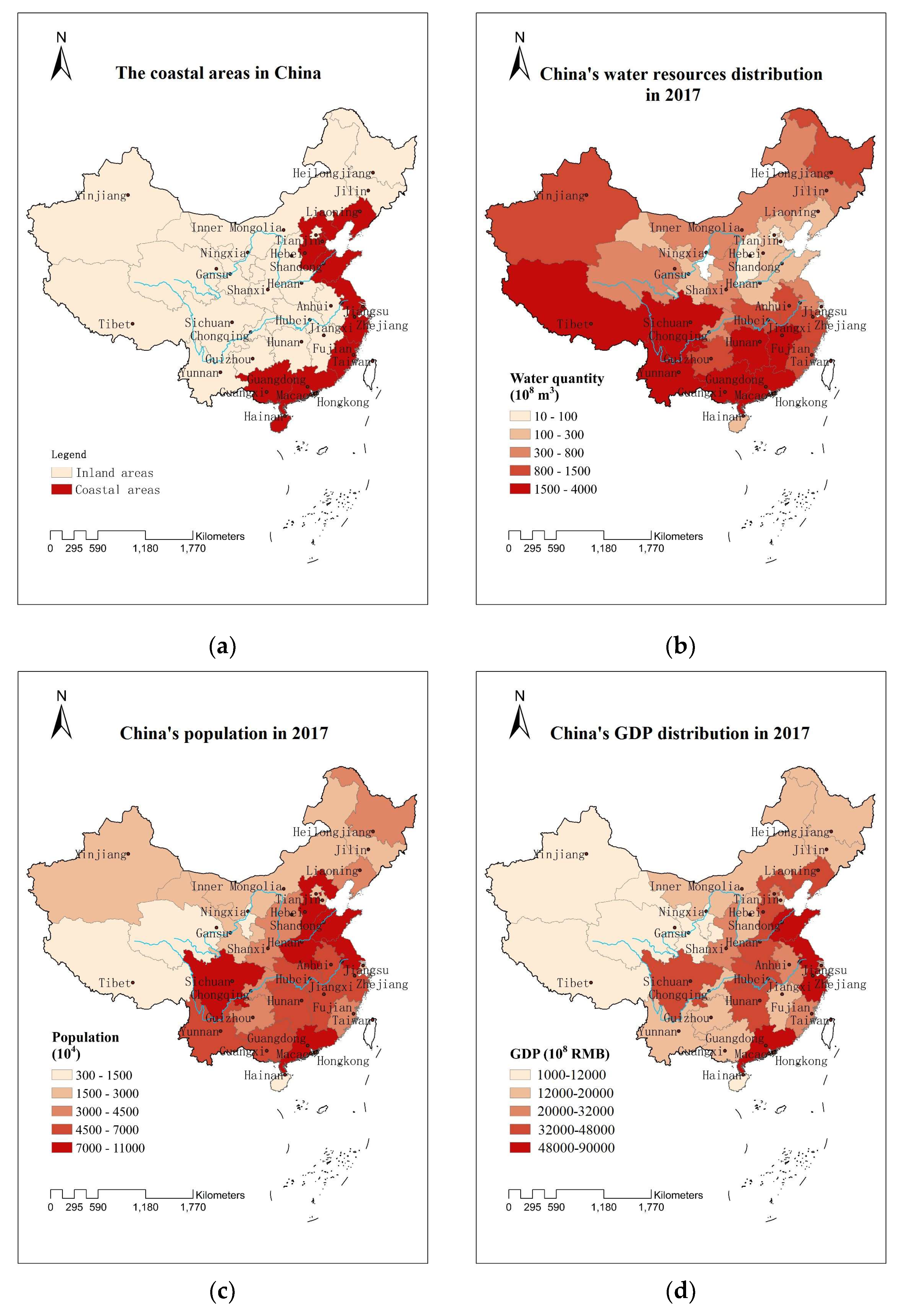


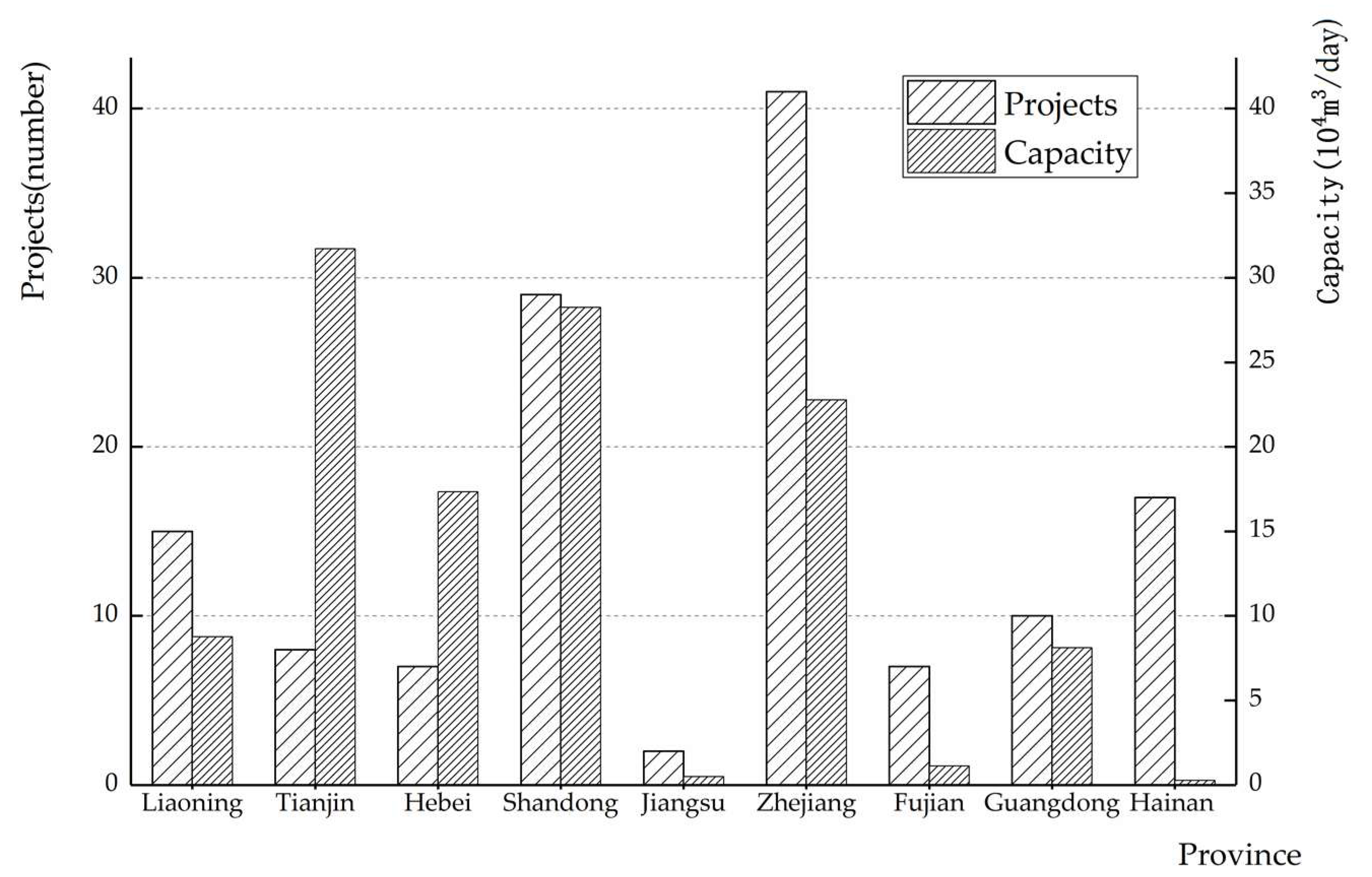
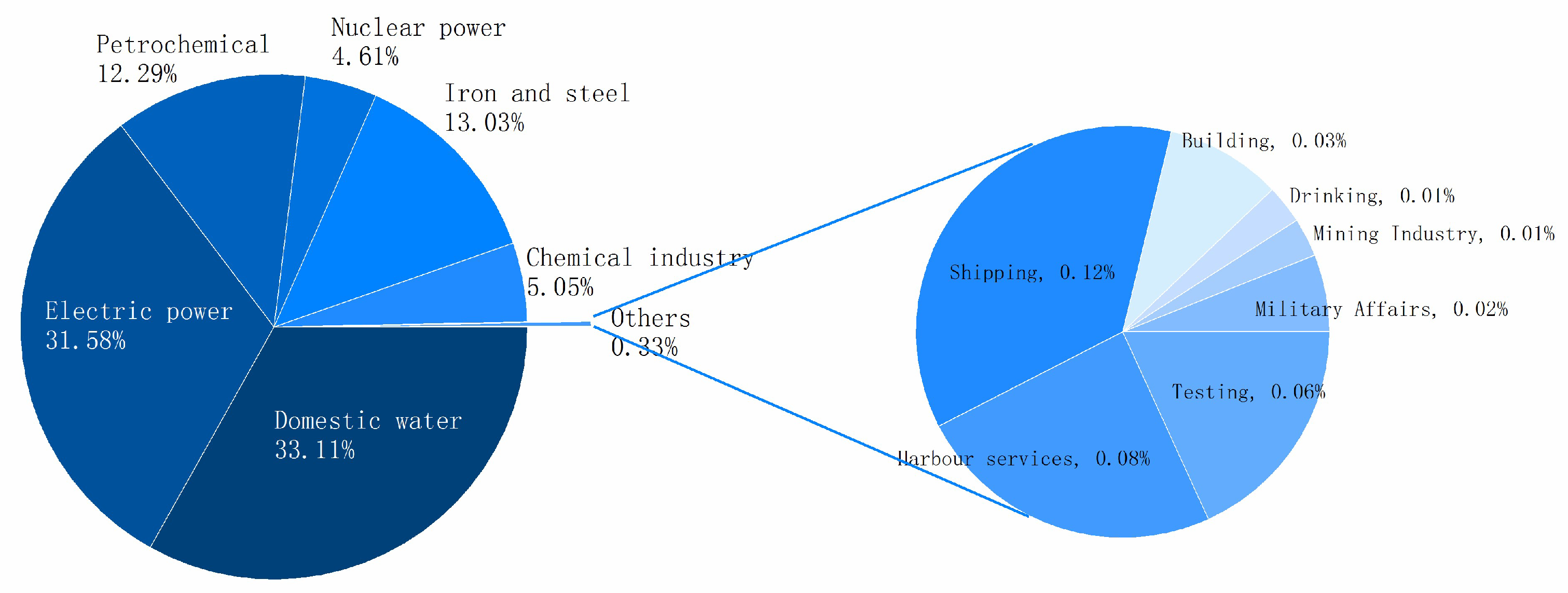
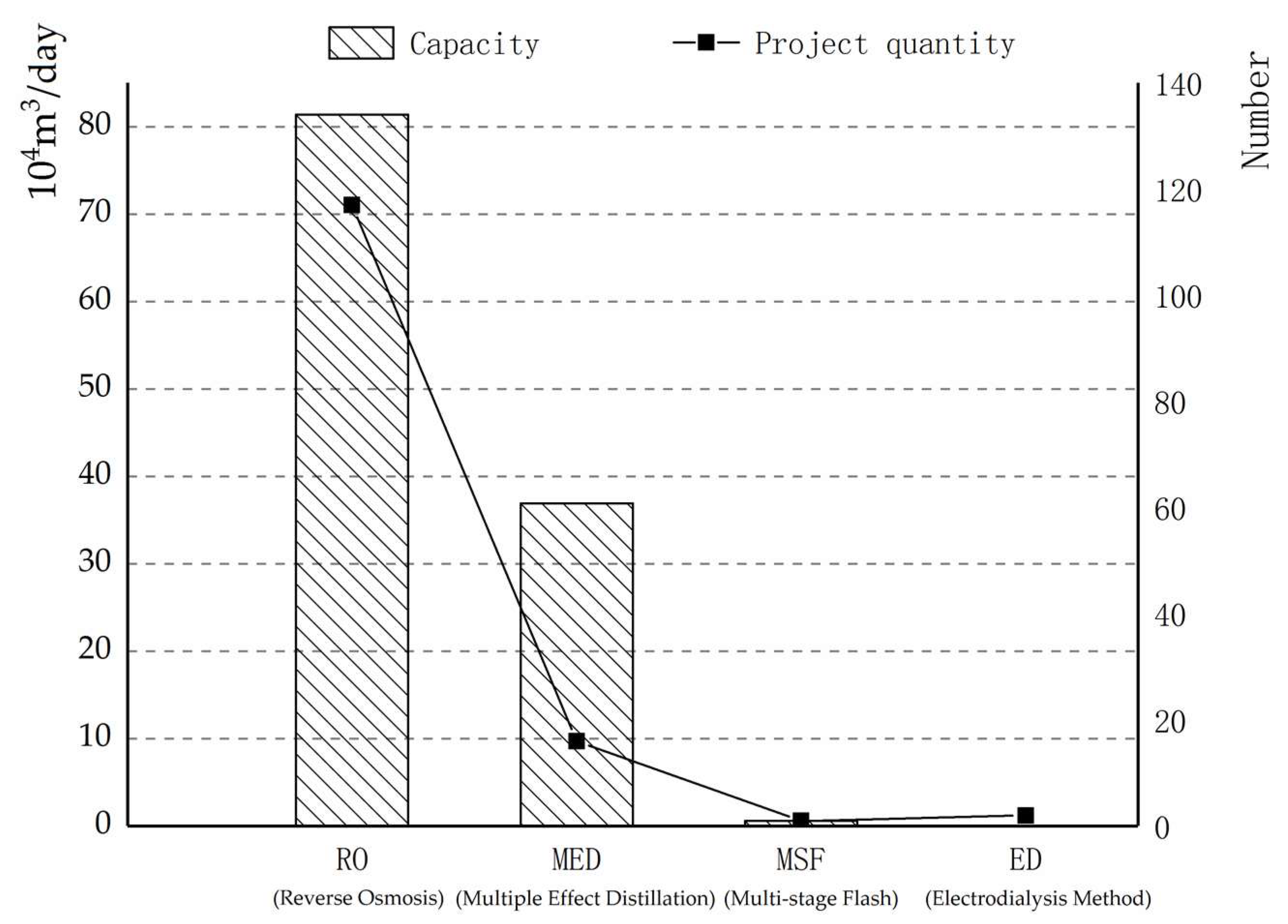
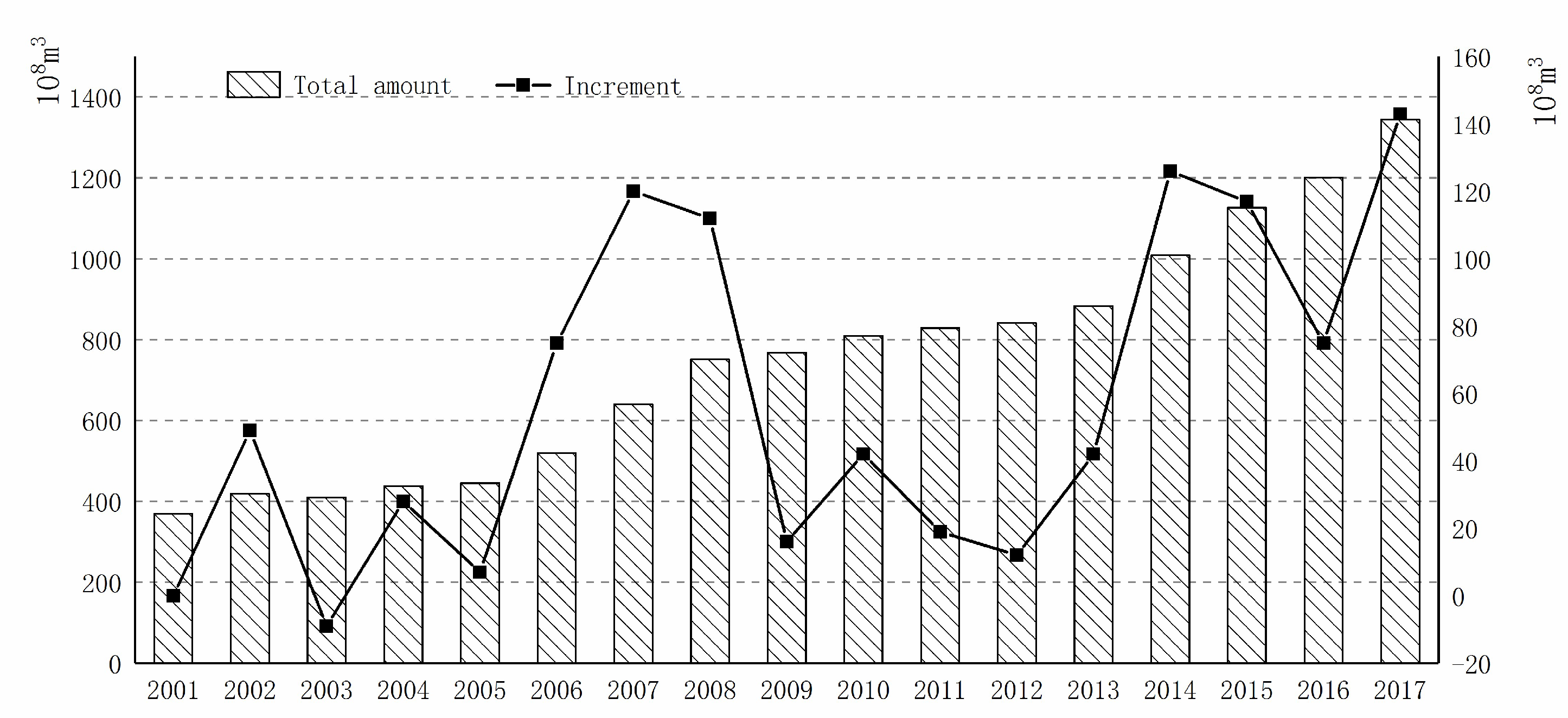
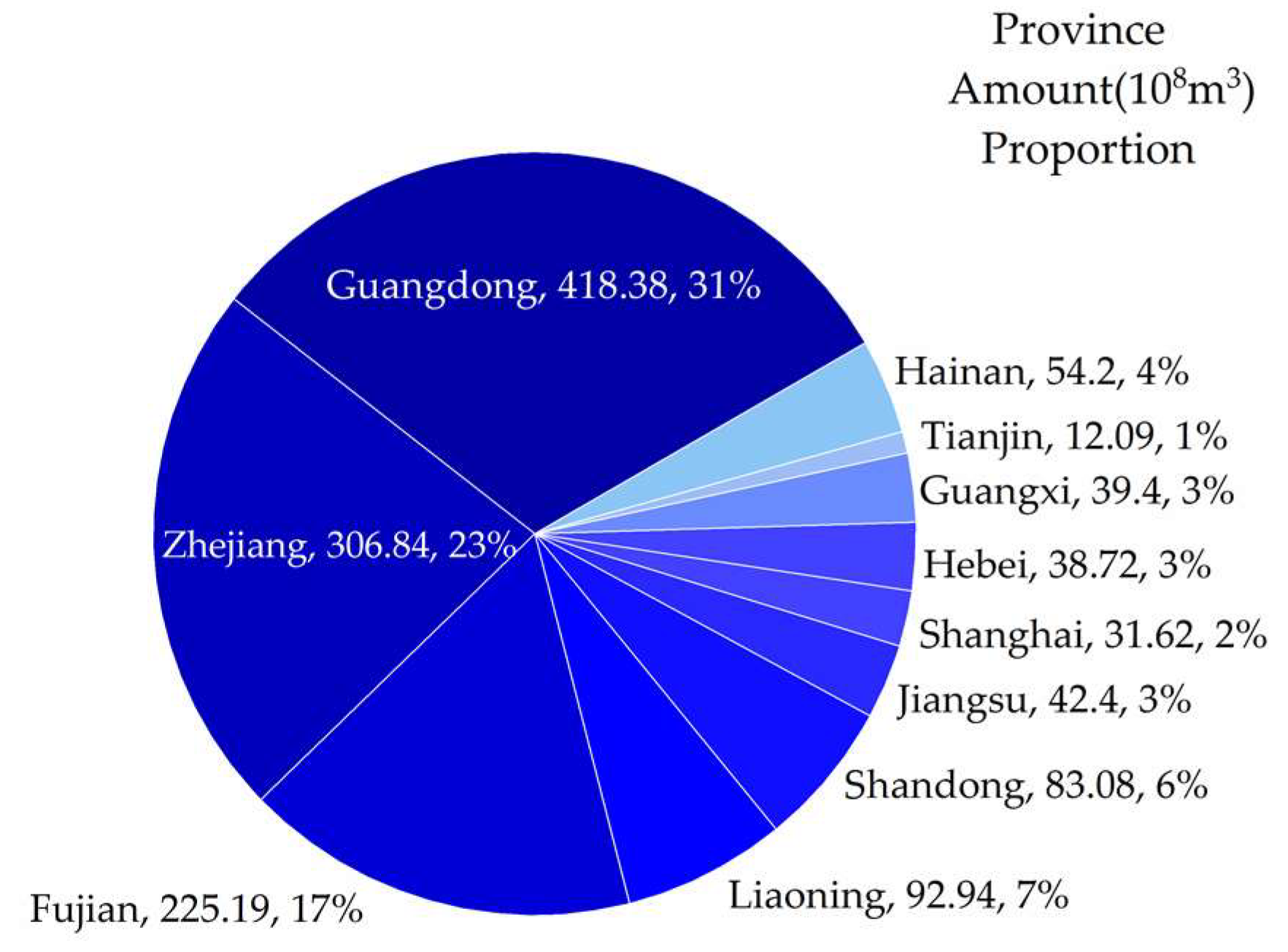
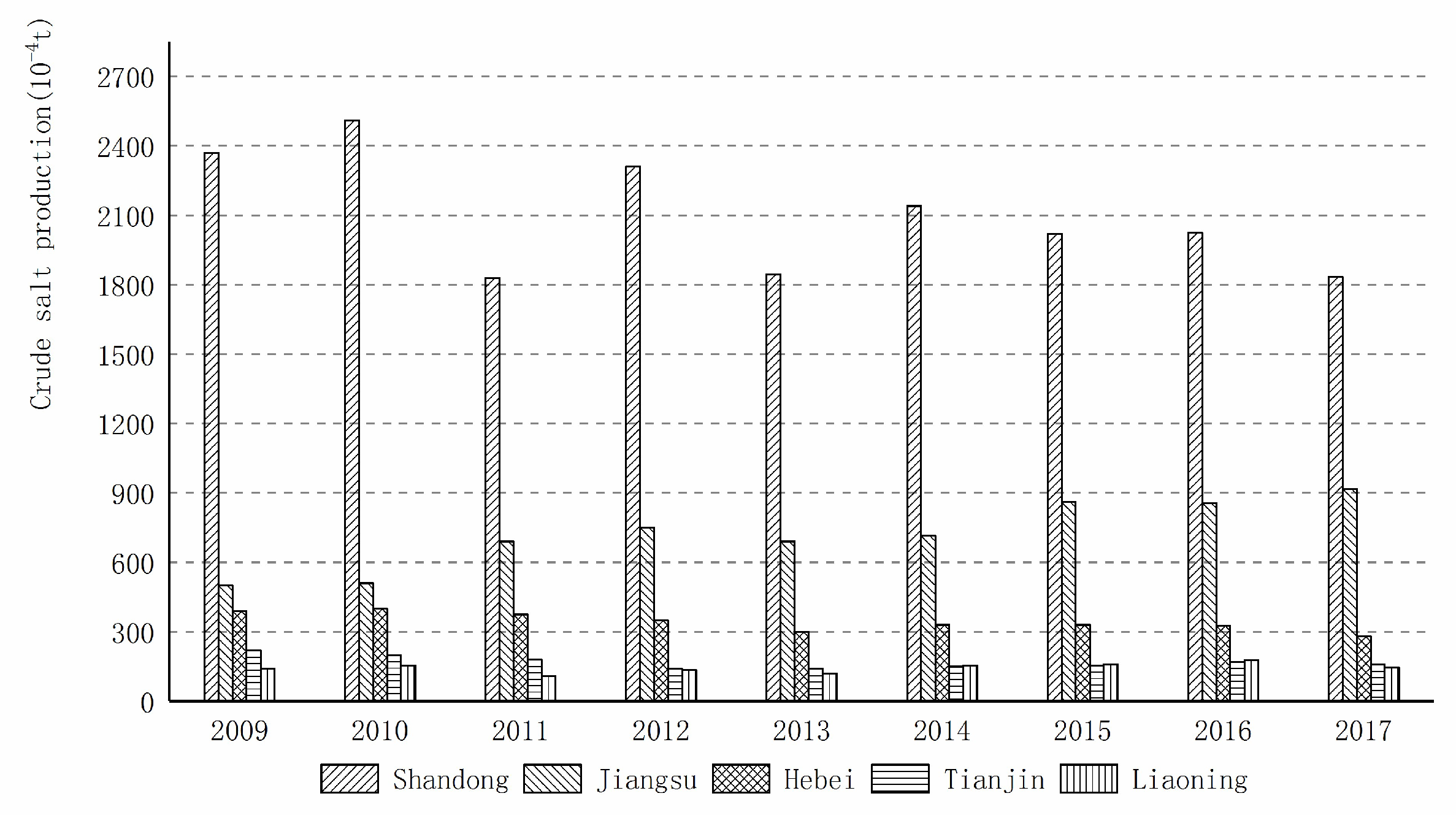
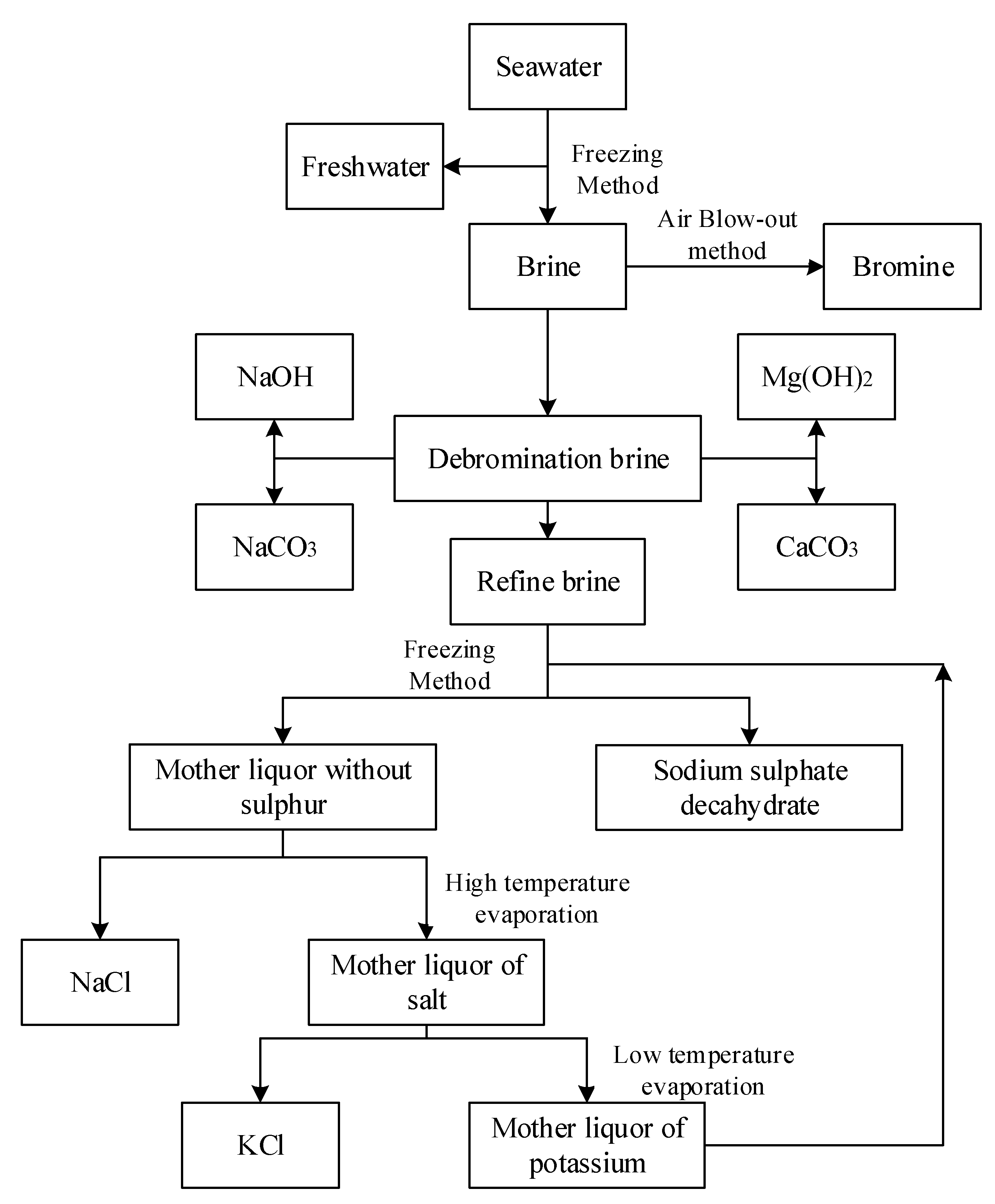
| Methods | Status Quo | Development Trend |
|---|---|---|
| Reverse osmosis desalination [44] | Practical application | Semipermeable membrane and membrane module |
| New technology and energy recovery | ||
| Low-temperature multi-effect distillation [44] | Practical application | Thermodynamics and fluid mechanics |
| Boiler-scale control | ||
| Materials and equipment | ||
| Combined with multi-stage flash distillation | ||
| Multi-stage flash distillation [44] | Practical application | Combined with nuclear power generation to set up large scale devices |
| Vapour compression distillation [45] | Practical application | Small and medium size |
| Solar distillation [45] | Research and development, small test and application | Applied in areas with strong sunlight |
| Crystallization method [45] | Research and development, small and medium test factory | Mud generation, transmission and thin ice separation and washing |
| Choice and recycling of solvent and water mixture | ||
| Electrodialysis method [45] | Practical application in desalination and marine salt producing | Membrane |
| High-temperature electrodialysis method | ||
| Combining desalination with comprehensive utilization | ||
| Solvent extraction method [45] | Research and development | Choice and recycling of solvent |
| Ion exchange method [45] | Practical application in pure water production | Resin synthesis and regeneration |
| 2009 | 2010 | 2011 | 2012 | 2013 | 2014 | 2015 | 2016 | 2017 | |
|---|---|---|---|---|---|---|---|---|---|
| NaOH | 1832.37 | 2228.39 | 2473.52 | 2696.82 | 2927.44 | 3063.51 | 3020.66 | 3201.68 | 3329.17 |
| Na₂CO₃ | 1944.77 | 2034.82 | 2294.03 | 2395.93 | 2431.63 | 2525.84 | 2591.80 | 2584.98 | 2767.14 |
| Level | Water Consumption (m3/household·year) | Price (RMB/m3) | Base Price (RMB/m3) | Water Resource Fee (RMB/m3) | Sewage Treatment Fee (RMB/m3) |
|---|---|---|---|---|---|
| First step | 0–180 | 4.9 | 2.61 | 1.39 | 0.9 |
| Second step | 181–240 | 6.2 | 3.91 | 1.39 | 0.9 |
| Third step | 240 | 8 | 5.71 | 1.39 | 0.9 |
© 2019 by the authors. Licensee MDPI, Basel, Switzerland. This article is an open access article distributed under the terms and conditions of the Creative Commons Attribution (CC BY) license (http://creativecommons.org/licenses/by/4.0/).
Share and Cite
Gong, S.; Wang, H.; Zhu, Z.; Bai, Q.; Wang, C. Comprehensive Utilization of Seawater in China: A Description of the Present Situation, Restrictive Factors and Potential Countermeasures. Water 2019, 11, 397. https://doi.org/10.3390/w11020397
Gong S, Wang H, Zhu Z, Bai Q, Wang C. Comprehensive Utilization of Seawater in China: A Description of the Present Situation, Restrictive Factors and Potential Countermeasures. Water. 2019; 11(2):397. https://doi.org/10.3390/w11020397
Chicago/Turabian StyleGong, Shuxin, Hongrui Wang, Zhongfan Zhu, Qijie Bai, and Cheng Wang. 2019. "Comprehensive Utilization of Seawater in China: A Description of the Present Situation, Restrictive Factors and Potential Countermeasures" Water 11, no. 2: 397. https://doi.org/10.3390/w11020397
APA StyleGong, S., Wang, H., Zhu, Z., Bai, Q., & Wang, C. (2019). Comprehensive Utilization of Seawater in China: A Description of the Present Situation, Restrictive Factors and Potential Countermeasures. Water, 11(2), 397. https://doi.org/10.3390/w11020397








